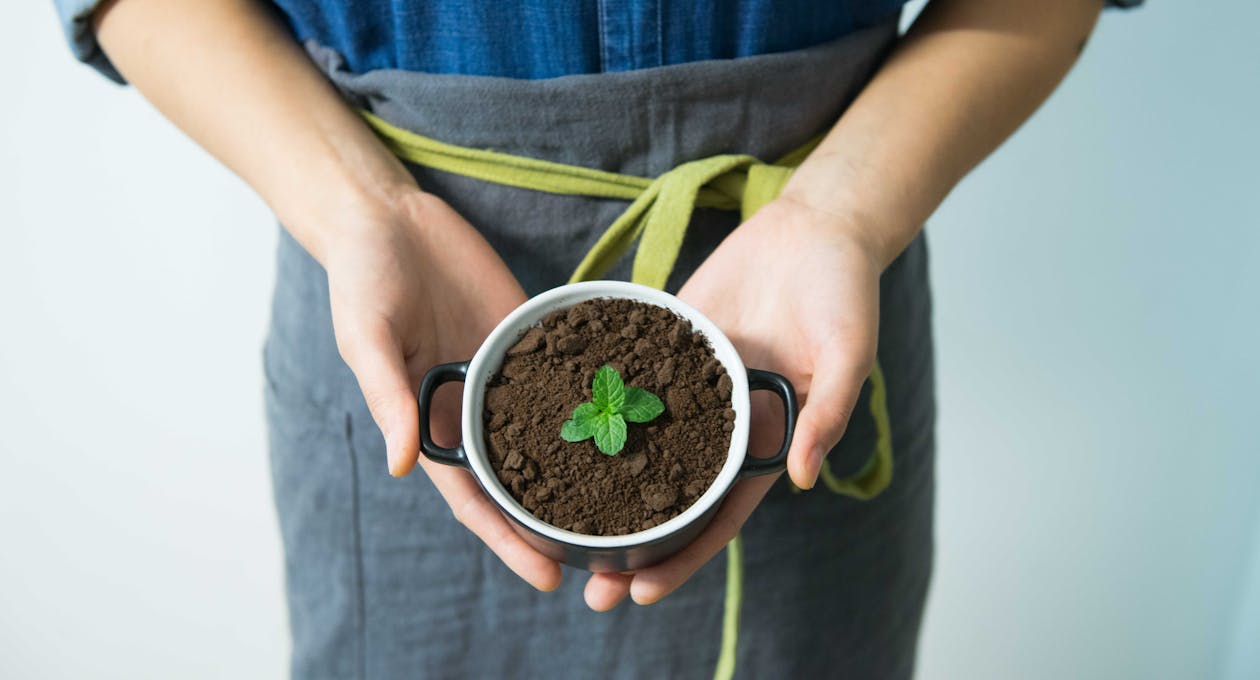In the enchanting realm of gardens, a surprising ally emerges from our morning brews. Coffee, a staple in our daily routines, holds a hidden secret in its grounds—a treasure trove for plants. As we delve into the profound connection between coffee and plants, a world of organic growth and vibrant blooms unfolds.
Supported by insights from the National Coffee Association, this journey into gardening with coffee reveals nature's intricate balance.
Key Takeaways
- Coffee grounds enrich soil with essential nutrients.
- Certain plants, like azaleas and roses, thrive with coffee.
- Used coffee grounds can deter pests and attract earthworms.
- Moderation is key; too much coffee can harm plants.
- Coffee grounds enhance composting, boosting garden health.
Coffee Grounds: A Gardener's Best Friend
Within the coarse textures of used coffee grounds lie the secrets to healthier soil and vibrant plant growth. The University of Minnesota Extension highlights coffee grounds' rich nitrogen content, making them an excellent addition to compost or directly in the soil. Yet, the benefits don't stop at nutrition.
Coffee's natural acidity and abrasive texture make it a formidable foe against common garden pests, providing an organic solution to protect your green oasis.
The Perfect Match: Plants and Coffee
Not all plants desire the buzz of caffeine. Yet, for those like hydrangeas, rhododendrons, and azaleas, the acidic nature of coffee grounds mirrors the pH levels they naturally crave. These acid-loving plants find in coffee a friend, a nurturer that echoes the forest floors they originate from.
Incorporating coffee into your gardening routine can transform it, bringing a touch of the wild, a whisper of the untamed woods, right into your backyard.
Integrating Coffee Grounds Effectively
While the allure of using coffee grounds is strong, moderation and method are key. A sprinkle here, a mix there—integrating coffee into your garden is an art. It's not just about scattering; it's about understanding and respecting the balance of your soil's ecosystem.
Learn from the masters at Gardener's Path, who guide through the nuanced ways of using coffee in gardening, ensuring that each grain of coffee works in harmony with your soil.

Photo by Cats Coming from Pexels
Coffee Grounds and Plants: A Local Touch
In the heart of Easton, a community thrives, blending the love for coffee with the passion for plants. Local cafes and nurseries, inspired by the global trend, have embraced the marriage of coffee and horticulture, creating spaces where both can flourish. It's not just a trend; it's a lifestyle, a testament to the sustainable, interconnected world we strive for. Dive into this local movement, see how coffee grounds breathe life into urban gardens, and bring a piece of this eco-conscious ethos into your own space.
The Secret Ingredients: Coffee Grounds and Eggshells
In every kitchen, a potential garden grows. The combination of coffee grounds and eggshells offers a powerhouse of nutrients, each complementing the other. The calcium-rich eggshells balance the acidity of coffee, creating a nutrient-dense cocktail for plants. This duo, when introduced to the soil, sparks a symphony of growth, a dance of elements that nourishes and protects. Embrace these everyday wonders, and watch as your garden transforms into a testament to nature's resilience and abundance.
A Step-by-Step Guide to DIY Fertilizer
Embark on a journey of transformation, turning your kitchen waste into gold for your garden. With guidance from renowned platforms like Gardening Know How, crafting your own fertilizer becomes an adventure, a foray into the alchemy of nature. This journey isn't just about feeding your plants; it's about creating a cycle of sustainability, a loop where every end is a new beginning, every waste a new wealth.
What Happens When You Use Coffee Grounds in the Garden?
In this exploration of coffee and plants, the ordinary becomes extraordinary. From the comforting warmth of a morning cup to the lush greenery of a thriving garden, coffee emerges not just as a beverage, but as a catalyst for growth, a symbol of the cycles that sustain us.
Join us as we delve deeper, uncovering more secrets, more connections, more ways to make our world a little greener, one cup, one plant at a time.
Continuing from our rich narrative about the symbiotic relationship between coffee and plants, we venture further into the practical applications, innovative community initiatives, and some frequently asked questions to help you seamlessly integrate these insights into your gardening practices.
Transforming Urban Landscapes with Coffee and Plants
Urban gardening, a revolution in its own right, finds a robust ally in coffee grounds. In metropolitan havens, where concrete often overshadows green, coffee grounds offer a beacon of hope, a promise of renewal. Initiatives like community gardens in Easton are not just transforming spaces; they're reviving spirits, knitting communities closer with every plant that rises from the soil enriched by coffee.
This green movement goes beyond aesthetics; it's about building resilience, fostering a sense of belonging, and nurturing a sustainable relationship with our environment.
The Community Garden: A Hub of Green Innovation
In the heart of the city, community gardens emerge as hubs of innovation and togetherness. Here, coffee grounds find new purpose, invigorating soil, and empowering urban dwellers to cultivate their patches of green. These gardens are more than collections of plants; they are vibrant ecosystems where education, community engagement, and environmental stewardship converge.
They stand as testaments to what we can achieve when we come together, pooling our resources and creativity for a greener, more sustainable future.
Sustainable Practices in Urban Gardening
Sustainability isn't just a buzzword; it's a commitment, a lifestyle adopted by urban gardeners who see the value in every scrap of organic waste. Coffee grounds, alongside other compostable kitchen waste, become pivotal in this movement.
By transforming what was once waste into a resource, these gardeners are not just nurturing plants; they're nurturing a philosophy, a way of life that resonates with the rhythms of nature, respecting its cycles and embracing its abundance.
Nurturing Your Garden: Advanced Tips and Tricks
As you embrace the journey of integrating coffee into your gardening regime, consider these advanced tips to refine your practices and ensure your green spaces thrive.
Monitoring Soil Health
While coffee grounds can significantly benefit your plants, monitoring your soil's health is crucial. Regularly test your soil's pH and nutrient levels to ensure the coffee grounds are contributing positively. Balance and moderation are key; too much of a good thing can tip the scales unfavorably. Be attentive, be mindful, and watch as your garden responds with vibrancy and vigor.
Creating a Balanced Ecosystem
Your garden is an ecosystem, a delicate balance of elements, each playing its vital role. Introduce coffee grounds thoughtfully, considering how they interact with other components like compost, mulch, and the specific needs of your plants. It's about creating harmony, a symphony of elements that together, create a chorus of growth and sustainability.
Frequently Asked Questions (FAQs)
-
How often should I add coffee grounds to my garden?
- Moderation is key. Start by adding a thin layer of coffee grounds to your soil or compost once a month, and observe how your plants respond. Adjust based on your plants' needs and the specific conditions of your garden.
-
Can coffee grounds harm some plants?
- Yes, while many plants thrive with the addition of coffee grounds, others might not. Plants that prefer alkaline soil, like lavender and geranium, may not respond well to the acidic nature of coffee grounds. Always research or consult an expert about your specific plants' needs.
-
Are there other uses for coffee grounds in the garden besides fertilizer?
- Absolutely! Coffee grounds can also be used as a natural pest deterrent, especially for slugs and ants. Additionally, they can attract beneficial worms which help aerate and enrich the soil.
-
Can I use fresh coffee grounds, or should they be used?
- It's best to use used coffee grounds as fresh ones can be too acidic. Used coffee grounds have a near-neutral pH, making them more suitable for most gardening purposes.
-
How do I store coffee grounds for gardening?
- Dry the coffee grounds thoroughly before storing them to prevent mold. Keep them in a breathable container like a burlap bag or a container with ventilation holes. Store in a cool, dry place until you're ready to use them in your garden.
Concluding Thoughts: The Rich Symphony of Coffee and Plants
As we've journeyed through the aromatic lanes of coffee and the lush trails of gardening, a vivid tapestry of interconnection has emerged. Coffee, in its essence, is more than a beverage; it's a catalyst for growth, a nurturer of life, and a symbol of sustainability.
Integrating coffee grounds into your gardening practices isn't just about enhancing the health of your plants; it's about embracing a philosophy of renewal and respect for nature's cycles.
In the heart of urban landscapes and the tranquility of personal gardens, coffee grounds offer a testament to nature's resilience and abundance. They remind us that in every cup, there's a potential for growth, for transformation, and for a greener future.
As you integrate these insights into your gardening practices, remember that you're part of a larger symphony, a collective endeavor to nurture our green spaces and, in turn, nurture ourselves.
Embrace this journey with mindfulness and joy, and watch as your garden, enriched by the essence of coffee, blooms into a vibrant testament to the harmonious dance of nature. Here, in the soil and in our hands, lies the promise of renewal, the seeds of a sustainable future, and the enduring legacy of coffee and plants, intertwined in the rich tapestry of life.












